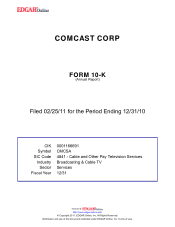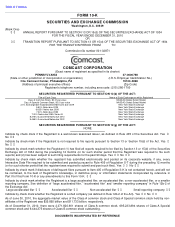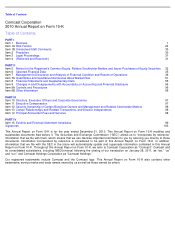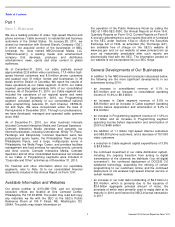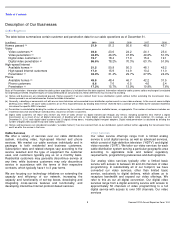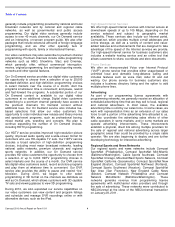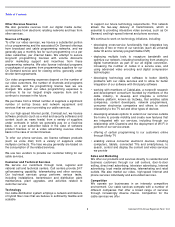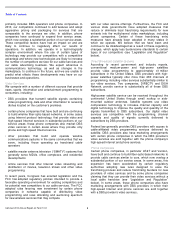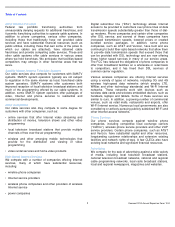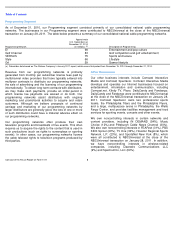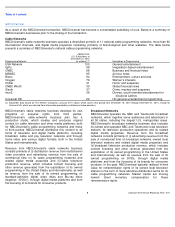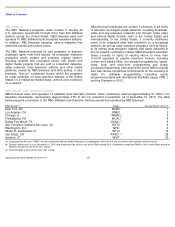Comcast 2010 Annual Report Download - page 10
Download and view the complete annual report
Please find page 10 of the 2010 Comcast annual report below. You can navigate through the pages in the report by either clicking on the pages listed below, or by using the keyword search tool below to find specific information within the annual report.
Table of Contents
Comcast 2010 Annual Report on Form 10-K
6
primarily includes DBS operators and phone companies. In
2010, our competitors continued to add features and adopt
aggressive pricing and packaging for services that are
comparable to the services we offer. In addition, phone
companies have continued to expand their service areas,
which now overlap a substantial portion of our service areas.
These competitive factors have had an impact on and are
likely to continue to negatively affect our results of
operations. In addition, we operate in a technologically
complex environment where the use of certain types of
technology may provide our competitors with a competitive
advantage and where new technologies are likely to increase
the number of competitors we face for our cable services and
our cable advertising business. We expect advances in
communications technology, as well as changes in the
marketplace, to continue in the future, and we are unable to
predict what effects these developments may have on our
businesses and operations.
Video Services
We compete with a number of different sources that provide
news, sports, information and entertainment programming to
consumers, including:
In recent years, Congress has enacted legislation and the
FCC has adopted regulatory policies intended to provide a
favorable operating environment for existing competitors and
for potential new competitors to our cable services. The FCC
adopted rules favoring new investment by certain phone
companies in networks capable of distributing video
programming and rules allocating and auctioning spectrum
for new wireless services that may compete
•
DBS providers that transmit satellite signals containing
video programming, data and other information to receiving
dishes located on the customer
’
s premises
•
certain phone companies that have built and are continuing
to build wireline fiber-optic-
based networks, in some cases
using Internet protocol technology, that provide video and
high-
speed Internet services in substantial portions of our
service areas; these phone companies also market DBS
video services in certain areas where they provide only
phone and high-speed Internet service
•
other providers that build and operate wireline
communications systems in the same communities that we
serve, including those operating as franchised cable
operators
•
satellite master antenna television (“SMATV”)
systems that
generally serve MDUs, office complexes, and residential
developments
•
online services that offer Internet video streaming and
distribution of movies, television shows and other video
programming
with our video service offerings. Furthermore, the FCC and
various state governments have adopted measures that
reduce or eliminate local franchising requirements for new
entrants into the multichannel video marketplace, including
phone companies. Certain of these franchising entry
measures have already been adopted in many states in
which we operate. We believe that we have been and
continue to be disadvantaged as a result of these regulatory
changes, which apply less burdensome standards to certain
types of our competitors (see “Legislation and Regulation”
below).
Direct Broadcast Satellite Systems
According to recent government and industry reports,
conventional medium-power and high-power satellites
provide video programming to approximately 41 million
subscribers in the United States. DBS providers with high-
power satellites typically offer more than 280 channels of
programming, including video services substantially similar to
our video services. Two companies, DIRECTV and DISH
Network, provide service to substantially all of these DBS
subscribers.
High-power satellite service can be received throughout the
continental United States through small rooftop or side-
mounted outdoor antennas. Satellite systems use video
compression technology to increase channel capacity and
digital technology to improve the quality and quantity of the
signals transmitted to DBS subscribers. Our digital video
services are competitive with the programming, channel
capacity and quality of signals currently delivered to
subscribers by DBS providers.
Federal law generally provides DBS providers with access to
cable-affiliated video programming services delivered by
satellite. DBS providers also have marketing arrangements
with certain phone companies in which the DBS provider
’s
video services are sold together with the phone company’s
high-speed Internet and phone services.
Phone Companies
Certain phone companies, in particular AT&T and Verizon,
have built and continue to build fiber-optic-based networks to
provide cable services similar to ours, which now overlap a
substantial portion of our service areas. In some areas, this
expansion has been accelerated by certain regulatory
authorities adopting new rules designed to ease the
franchising process and reduce franchising burdens for new
providers of video services and by some phone companies
claiming that they can provide their video services without a
local cable franchise (see “Legislation and Regulation”
below). In some areas, these phone companies also have
marketing arrangements with DBS providers in which their
high-speed Internet and phone services are sold together
with a DBS provider
’s video services .

